Don M. Winn's Blog, page 35
April 17, 2012
A Visit to Grandview Hills Elementary
I had a lot of fun visiting Grandview Hills Elementary School last week. I got to meet the third-grade classes and their teachers, and we had a good time thinking up story ideas.
 I gave my “How to Write an Animal Fable” writing workshop, and during the workshop, after discussing different elements of a fable, we brainstormed and came up with an outline for students to write their own fable. Everyone had a LOT of good ideas that they wanted to share, as you can see from the picture at the left.
I gave my “How to Write an Animal Fable” writing workshop, and during the workshop, after discussing different elements of a fable, we brainstormed and came up with an outline for students to write their own fable. Everyone had a LOT of good ideas that they wanted to share, as you can see from the picture at the left.
There were four big tables of students, so after discussing each story element, like the setting or the character, I gave the students a few minutes to come up with ideas. Then each table shared their favorite idea with everyone else. We wrote all four ideas down on a white board and then the teachers helped by voting on which one they liked best. We got some good results for a possible fable this way, and in case any of the students need a quick reminder of the story plan we made, here it is:
The Problem: The character always leaves other people out.
The Lesson: Treat other people the way you would like to be treated.
The Main Character: A selfish, lazy cat. (There were lots of other personality ideas we thought of for this cat, but I’m only including a few just as a reminder.)
Another Character who helps the main character learn the lesson: A dog.
The Setting: A school.
I really like this story idea, because you hardly ever
read about a cat being helped by a dog.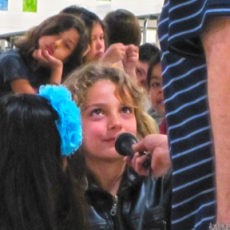 It makes me think of all sorts of interesting ways this could happen. I can’t wait to see what kind of stories everyone writes, because in connection with this visit, I am sponsoring my first writing contest for the third-grade students at this school. They can send me an animal fable based on the characters and other details we discussed during my visit, an animal fable they invented all by themselves, or a tall tale, and I will give out a first, second and third prize to the three winning stories.
It makes me think of all sorts of interesting ways this could happen. I can’t wait to see what kind of stories everyone writes, because in connection with this visit, I am sponsoring my first writing contest for the third-grade students at this school. They can send me an animal fable based on the characters and other details we discussed during my visit, an animal fable they invented all by themselves, or a tall tale, and I will give out a first, second and third prize to the three winning stories.
We had some other interesting suggestions on the supporting characters for this story. One of the ideas was that a whale would help the cat learn its lesson. I’m not sure what kind of school has both whales and cats for students, or how a whale could help a cat, but I do know one thing…there’s got to be a great story that explains how that would work!
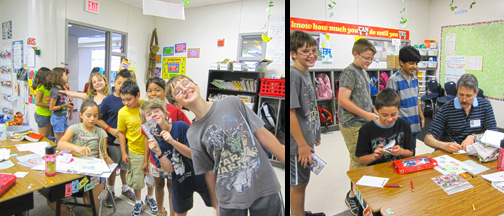
Students waiting to get their signed postcard featuring the Sir Kaye series.
April 10, 2012
To Knit or Not to Knit?
That is the question. In my children's novel that I am working on now, the hero is a very young knight who can also knit. Back in the middle ages, the knowledge of knitting was not widespread, but it was valuable knowledge, since knitted items were in high demand. Knitting was a field dominated by men for quite some time. So young Kaye learns to knit from his Grandfather Wulfric. Kaye proves to have a great talent for knitting…he is very, very fast at it.
How fast can he knit? Well, how fast can anyone knit? I did a little research on the topic and found that Hazel Tindall holds a record for really fast knitting at 262 stitches in 3 minutes.
Here's a link to an interview with Hazel Tindall that was uploaded in 2010. I'm not sure if she still holds the record for fastest knitter, but for the purposes of my research, 262 stitches in 3 minutes is really fast and yet is still humanly possible…for a few humans, anyway…and that includes the hero of my book, Sir Kaye.
In the interests of research, I had a friend give me a knitting lesson just so I could try to get inside my main character a little bit.
I think I may need a few more lessons. And also some more friends who knit to volunteer to read over my manuscript to let me know if I made any major errors where I've written about knitting. On the brighter side, I now have a much deeper understanding of Kaye's best friend Reggie, who also got a few knitting lessons from Kaye and then decided it was not one of his talents. This works out well though, since Reggie narrates the whole story…I need to identify with him too!








April 3, 2012
A Knight Who Knits?
The children's novel I'm working on right now is called The Knighting of Sir Kaye. Kaye lives in the mid to late middle ages in a fictional country called Knox and he is only 12 years old when he is knighted…much to everyone's surprise. But Kaye has other surprises as well. He happens to be a very talented and speedy knitter.
Why and how? Interesting question, which required me to do a little research into the  history of knitting. First of all (and possibly conveniently for me, because I can make up the details to fit my story) the history of knitting is somewhat shrouded in mystery. Examples of early forms of knitting have been found in Egypt, and it was most likely developed in the Middle East and later spread to Europe. There are examples of knit items found in Europe dating back to at least 1275.
history of knitting. First of all (and possibly conveniently for me, because I can make up the details to fit my story) the history of knitting is somewhat shrouded in mystery. Examples of early forms of knitting have been found in Egypt, and it was most likely developed in the Middle East and later spread to Europe. There are examples of knit items found in Europe dating back to at least 1275.
During the 13th and 14th centuries, knitting became more and more important because knit items were stretchy and could shape themselves to a person's body. This allowed for greater freedom of movement as well as nicer-looking stockings that didn't bag around the knees. Keep in mind that the fashions of the time required people to wear hose a lot…especially men. Women could still get away with wearing long skirts, so maybe they didn't need nicely knitted hose, but men often had shorter tunics which they wore with knitted hose. So maybe it shouldn't be surprising that knitting was actually considered a man's job for many years. Eventually there were even knitting guilds, which were of course run by men.
Initially, knitted goods were considered luxury items, and they could be extremely expensive, but as time went on, the knowledge of knitting spread and by the time Elizabeth I was Queen of England, there were even knitting schools established to teach poor families a way to make a little extra money. (All right, I confess I learned that last fact from Wikipedia and there was no citation, so I hope it's accurate. As I research this a little further, if I find out it's not true, I'll let you know.)
Stay tuned for a little more information on knitting in general and on Sir Kaye, the knitting knight, who prefers that no one knows about his secret talent. After all, who ever heard of a knight who knits?
Did you find this short recap of the history of knitting fascinating? Check out this other article I found online in Knitty magazine and see if you like it too.








March 27, 2012
Using Reading to Talk Math with Kids
 I always like to encourage parents to read aloud with their kids and talk about what they've read. I've mentioned many social, psychological, and educational benefits of doing this. Usually when I mention educational benefits, I mention things like improving language skills and vocabulary.
I always like to encourage parents to read aloud with their kids and talk about what they've read. I've mentioned many social, psychological, and educational benefits of doing this. Usually when I mention educational benefits, I mention things like improving language skills and vocabulary.
But then I read a very interesting article on MindShift by Annie Murphy Paul that encourages parents to "talk math" with kids. Here's one point in particular: Because children are building their vocabularies at a young age, talking with them about numbers makes them familiar with "number words," which helps them be more comfortable with and interested in math once they are formally introduced to it in school.
So talking about math before kids start school helps them become familiar with basic math concepts, it gives them confidence that they can be good at it, it gives them enthusiasm for the subject, and it can even give them a little ego boost if they happen to realize they already know something their classmates are just about to learn.
Even if parents feel like they are terrible at math, the good news is that most parents are mathematical geniuses when compared to their baby/toddler/preschooler. I mean, it's possible that your infant has an amazing gift for numbers and will soon leave you in the dust mathematically speaking, but the other good news is that all parents can give their  children (geniuses or not) a mathematical start. This means talking about things like counting and drawing their attention to written numbers and little things like these.
children (geniuses or not) a mathematical start. This means talking about things like counting and drawing their attention to written numbers and little things like these.
It's also possible to incorporate math talk into your reading time. When reading picture books with kids, let them count the number of animals (or something else) on the page…then let them count the number of animals on the next page…then ask them how many animals are on both pages…your child may not know it, but they just solved a simple addition problem. And that's only one suggestion. What do you do to get your kids interested in numbers?








March 21, 2012
Looking Back on Life from a Fourth Grade Perspective
I had some interesting discussions with students at the Harmony School of Science on Monday this week. I visited there and read from my new book, Twitch the Squirrel and the Forbidden Bridge, to a group of first-graders and a group of fourth-graders. I also gave them a short preview of my new chapter book, The Knighting of Sir Kaye. They are very interested to see what the chapter book will be like.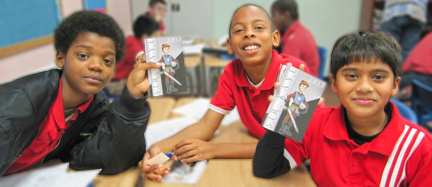 Both groups of students really seemed to enjoy Twitch. In case you didn't know, the story is about a young squirrel who disobeys his parents and crosses a dangerous bridge to try to get some really nice-looking acorns. On his way back, he learns really quickly why his parents told him to stay off that bridge. I think the first-grade students liked the story on its own, but the fourth-grade students and I had some nice discussions about the meaning of the story—maybe because fourth-graders are older and are able to look back on their early years with a little perspective now, so they really seemed to relate to the story. I heard many different experiences from students about rules their parents gave them that they didn't understand when they were younger but now they can say that they understand and appreciate the rules. Here's a few:
Both groups of students really seemed to enjoy Twitch. In case you didn't know, the story is about a young squirrel who disobeys his parents and crosses a dangerous bridge to try to get some really nice-looking acorns. On his way back, he learns really quickly why his parents told him to stay off that bridge. I think the first-grade students liked the story on its own, but the fourth-grade students and I had some nice discussions about the meaning of the story—maybe because fourth-graders are older and are able to look back on their early years with a little perspective now, so they really seemed to relate to the story. I heard many different experiences from students about rules their parents gave them that they didn't understand when they were younger but now they can say that they understand and appreciate the rules. Here's a few:
Go to sleep when you should be asleep so you don't oversleep and get to school late.
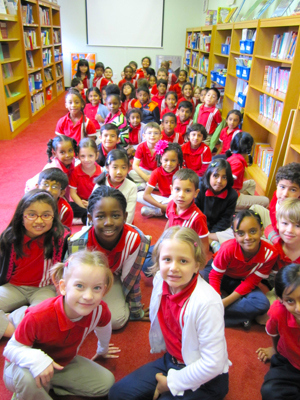
Do your homework so you can get good grades.
Don't go look at toys when your mom is shopping for other things and she says not to. You can get lost.
Don't play with your dad's razor. If you're little you might cut half your eyebrow off.
Don't play football in the house. Stuff breaks.
Don't play with scissors. You might stab yourself by accident and still have the mark. Or you might cut your eyelashes off.
Don't climb on the roof and act like a fireman when you're really little.
Look both ways before crossing the street.
Wearing seatbelts makes sense if you think about it.
I also heard a sad story about someone's cousin who broke his foot and after that, when his mom told him not to go on his skateboard, he didn't listen and he went on his skateboard anyway and then he broke his other foot. Then one of the teachers shared a story about how her mom once told her not to ride her bike outside of their neighborhood near a construction area and she did it anyway and got hurt, just like her mom had said would happen.
Everyone has a story to tell. But the general opinion was well-expressed by one of the students, when he said that "Parents have been alive way longer than you," and that their rules can help you out because they know more stuff.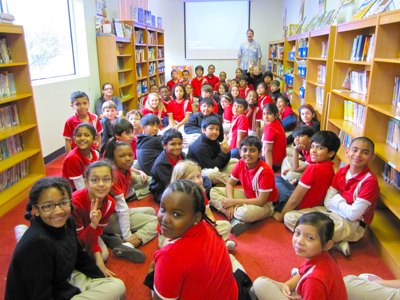 I also asked students what kind of rules they would make if they had their own children. Here are some of them:
I also asked students what kind of rules they would make if they had their own children. Here are some of them:
Play video games and do what you want, but don't do anything dangerous like go in the street.
Respect adults.
Do what you want, but if you're not sure, come ask my advice.
Never go onto a farm. You might step in a hole and sprain your ankle.
Never go on a giant bull ride. You will end up with a broken leg or sprained ankle.
Be careful of monster trucks.
So it's clear to me that these students understand the connection between respecting their parents' rules and staying safe. It's also clear to me that there's a few more interesting stories out there that I DIDN'T get to hear on Monday. I really wonder what happened to inspire the rule about monster trucks.

Here was a nice surprise I found when I turned a corner at the school. That's a good-looking board, if I do say so myself!








March 13, 2012
The Knighting of Sir Kaye Trailer
Along with the picture book trailers I mentioned last week, I've also had a trailer made for my upcoming novel The Knighting of Sir Kaye. I'm really excited about both this book and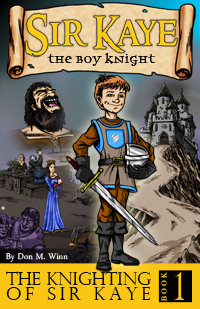 the trailer. See what you think of it! And here's the finished cover design for the book too!
the trailer. See what you think of it! And here's the finished cover design for the book too!
I hope this trailer will get a lot of people excited about reading the book once it's completed. Right now I'm hoping to have it finished by September, but I'll be posting updates about it periodically. If you're interested in finding out the minute it's available, you can go to my website and sign up to be on my newsletter mailing list. There's a link in the header of each page that will let you do that. Or you can click here to sign up for the CBA newsletter. Here's the trailer!
View the trailer for The Knighting of Sir Kaye on YouTube.








March 6, 2012
Twitch the Squirrel and the Forbidden Bridge Trailer
I'm excited to be sharing something new with everyone. I've started the process of making a trailer for each of the CBA books. The first one available to view is for the newest book, Twitch the Squirrel and the Forbidden Bridge, and I'm really happy with the way it came out. It's not too long, less than a minute and a half, so please check it out!
View the Twitch trailer on YouTube.
The trailer is also accessible from the CBA website. If you're not familiar with the CBA website, we've recently restructured it so that each book has its own page. There will be a link in a yellow bar on each book page to the trailer for that book. Stay tuned over the next few months as we gradually release the rest of the trailers. Check this blog for updates.
Close-up view of the Twitch page of the CBA website:








February 28, 2012
Hill Country Book Festival
Earlier this month I spent the day at the Hill Country Book Festival in Georgetown, Texas. This is a very nice venue, with air-conditioning and indoor bathrooms and coffee and snacks. The people who run the festival are very helpful and very dedicated to reading and writing. It's always a pleasant experience. And there was an excellent selection of free candy this time around.
Here's the free candy background: Most of the time when you set up at a book fair or  festival, the organizers of the event will recommend that you give away little gifts or prizes or keep a candy bowl to kind of entice people over to your table so they will look at your books. Most exhibitors will do all of that, so there's usually lots of free candy available at the festivals. If the candy picture at the right bothers you, don't worry. I only give away nice pieces of hygienic individually wrapped candy that comes in a big bag from the store. But you can't beat jellybeans for a beautiful picture of bright shiny candy. That's why it's here in the blog.
festival, the organizers of the event will recommend that you give away little gifts or prizes or keep a candy bowl to kind of entice people over to your table so they will look at your books. Most exhibitors will do all of that, so there's usually lots of free candy available at the festivals. If the candy picture at the right bothers you, don't worry. I only give away nice pieces of hygienic individually wrapped candy that comes in a big bag from the store. But you can't beat jellybeans for a beautiful picture of bright shiny candy. That's why it's here in the blog.
Sometimes it can be funny to watch visitors deal with the candy situation. It's true, people are drawn to candy. It can definitely bring them to your table. It's also true that a lot of people are just not interested in kids' picture books. But they still want the candy. So some will come by and look at the books briefly and then help themselves to candy and go. Which is fine with me. Others might walk by very fast and not make eye contact and just see what kind of candy they can quickly grab in passing. That's fine too. But I think my favorite candy friends are the people who just come right up to the candy bowl and ask me straight out if they may please have a piece of candy. They might just love me for my candy, but at least I can love them for their polite requests.
It seems like the Hill Country Book Festival is growing. This year there were some new authors and artists as well as some familiar faces at the exhibitor's tables. And it was nice to see some old friends in the crowd of visitors and to make some new ones as well. I hope that everyone is enjoying their books!
Here's the CBA table at the festival: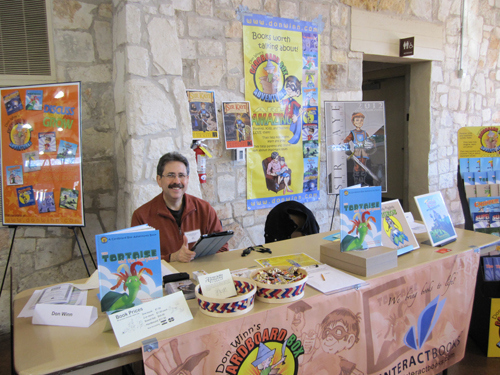
At this festival, Cardboard Box Adventures shared a table with InteractBooks, which recently released a great updated version of their free App. Richard, the InteractBooks representative that was at the festival with me, set up his iPad so the interactive books were visible on a much larger monitor. People always like to see what's on the big screen, so they stop by and take a look. This year, one of our younger visitors was a lot more interested in the cables and cords that made this possible than in what was on the screen. But he figured out most of the cables. I was pretty impressed with his technical instincts.
The winner of our prize drawing for a signed hardbound copy of The Tortoise and the Hairpiece was very happy and surprised. She said she never wins anything, and since she was one of the last people to leave the festival, we were able to deliver her prize in person.
Anyway, it's really nice to meet everyone who stops by. I love to hear stories about how parents have been able to use the books to help their kids or how much their kids like the books. Thanks so much for all your support and encouragement. It means a lot to me.









February 21, 2012
Your Time And Your Example…Two Things Your Child Will Never Forget
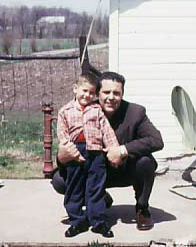 I have been thinking about my father lately. When I remember my childhood now, I often think more about the things I took for granted at the time than of all my childhood adventures. For example, I never had any doubts that my father loved me, it was just a given. And this, of course, is how it should be for any child. I know I received plenty of instruction and discipline as a child, but I hardly remember any of it now. Instead, it is my father's example that stays with me to this day. I learned so many things simply by watching him every day…from life lessons to little things, like tying a tie. I know for a fact that no one ever taught me how to tie a tie. But I know how to do it today because I watched my father tie his tie every morning before he went off to work.
I have been thinking about my father lately. When I remember my childhood now, I often think more about the things I took for granted at the time than of all my childhood adventures. For example, I never had any doubts that my father loved me, it was just a given. And this, of course, is how it should be for any child. I know I received plenty of instruction and discipline as a child, but I hardly remember any of it now. Instead, it is my father's example that stays with me to this day. I learned so many things simply by watching him every day…from life lessons to little things, like tying a tie. I know for a fact that no one ever taught me how to tie a tie. But I know how to do it today because I watched my father tie his tie every morning before he went off to work.
My father was already nearly fifty when I was born. He grew up during the Great Depression and learned early in life the importance of hard work and of doing his best. He tried to instill the same values in me. Of course at the time, I didn't appreciate the significance of my dad's wisdom, but as I became an adult my memories of him became all the more precious. I say memories, because my father passed away while I was still young. And though I didn't have the opportunity to know my father from an adult perspective, I can't imagine what my life would be like today without having had his love, discipline, and example during my early years, an example that I still draw on today.
I spent most of my time with Dad…when I wasn't playing of course. I loved to go with him on his sales calls and errands—I liked the lumberyard best. When he worked on his many home-improvement projects, I was always underfoot wanting to help, and graciously, he would let me, although it usually made more work for him. Even when he did paperwork, I was again underfoot with my own make-believe desk and a handful of very valuable junk mail, which I pulled out of the trash, pretending to be a businessman. I watched him when he shaved, shined his shoes, put on a tie, and I lobbed more questions his way than even Jimmy Connors could return. And last but not least, I was always there when he raided the ice box for a snack—homemade ice-cream was my favorite.
Not only did I learn by my father's example, I also learned that it's not just brief snippets of "quality time" that children need, but rather just plain old time…and lots of it. I know my father was a busy man. He had lots to do and I'm sure he dealt with lots of stressful problems in his life, as all adults do. But to this day I am impressed with the graciousness with which he included me in his many chores and activities. I never felt unwanted or like I was in the way. I always felt like it was just great to be with my dad and that he felt the same way about me as I was "helping" him.
What lessons do children learn from our example? Are we gracious and generous with our time, allowing our youngsters to copy our activities, and learning as they go? If so, then you are laying a foundation for your child that will last a lifetime.








February 14, 2012
School Visits to Hutto
I had a really nice visit to two elementary schools out in Hutto, Texas lately. At each school I read from my new book, Twitch the Squirrel and the Forbidden Bridge, and gave my How a Book is Made presentation.
I am so happy to find out how much kids are enjoying Twitch the Squirrel. Of course, I had hoped they would, and I wrote it for kids to enjoy, but since the theme of the book is essentially about listening to parents, I wasn't sure how it would be received by kids. I knew parents would like it. I've definitely been getting a lot of enthusiasm from parents about this book. But the Hutto librarian also mentioned that her students got really absorbed in the story of Twitch when she shared it with them before my visit. This is great news and I'm really excited! Maybe it's because it's got more action than some of my other stories…and I'm sure a lot of it has to do with Dave Allred's great illustrations. You can't have a picture book without the pictures!
There was some great audience participation at the Hutto schools during the How a Book is Made presentation. There were so many willing volunteers to help me with some "experiments" that demonstrate how authors choose the illustrator they will work with. Here's a picture of some students helping out with that part of the presentation. They did a great job! All of them got to choose a special edition CBA poster to thank them for volunteering.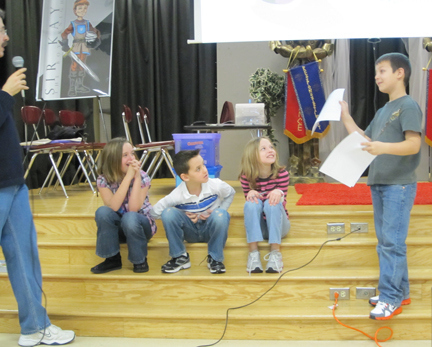
I also found out that in Hutto, they have a character education program in place for students in grades K-8 called Early Act First Knight that encourages and rewards students 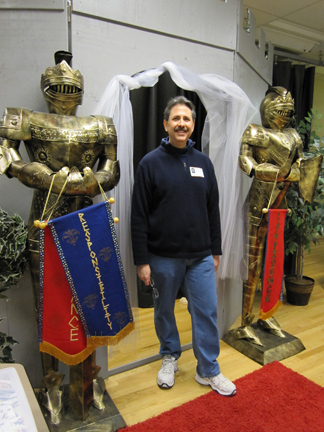 for demonstrating good qualities that will be of value in the community. Students who receive recognition from their teachers can be knighted (over time…they have to move up through the ranks of page, squire and knight) in special knighting ceremonies. Of course I think this is really cool…especially since knights are featured heavily in my new series of chapter books. I think I'll definitely have to go back for another visit to Hutto once the book is ready for readers.
for demonstrating good qualities that will be of value in the community. Students who receive recognition from their teachers can be knighted (over time…they have to move up through the ranks of page, squire and knight) in special knighting ceremonies. Of course I think this is really cool…especially since knights are featured heavily in my new series of chapter books. I think I'll definitely have to go back for another visit to Hutto once the book is ready for readers.
Side note: Here's a recent interview of me published in Education News by Michael Shaughnessy, Professor of Educational Studies, Eastern New Mexico University.





















